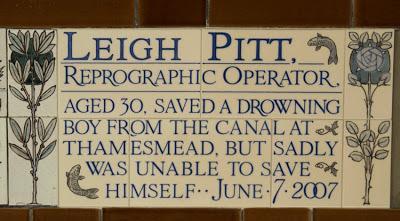
Leigh Pitt jumped into the canal at Thamesmead to rescue a nine-year-old boy who had fallen in while playing. He succeeded in holding the child, Harley Bagnall-Taylor, above water until passers-by could pull him out using a hosepipe. However, because of the high canal walls, Mr Pitt was unable to get out himself and drowned.
His colleagues, particularly Jane Michele, and his fiancée Hema Shah persuaded the Diocese of London to allow a plaque to be added to the Memorial. It was unveiled in the presence of the Lady Mayoress.
The design, wording, and above all the bravery they record fit perfectly into the memorial. Watts would have approved of Ms Shah's comment that 'I would hope Leigh's actions would inspire someone to help another'. That was exactly what he intended for the memorial.
Leigh Pitt's plaque reads:
LEIGH PITT, REPROGRAPHIC OPERATOR, AGED 30, SAVED A DROWNING BOY FROM THE CANAL AT THAMESMEAD, BUT SADLY WAS UNABLE TO SAVE HIMSELF, JUNE 7 2007
The Diocese of London indicated that they would consider other applications for plaques commemorating 'acts of remarkable heroism'. Another name was soon put forward: the Rev Stephen Arkwright, who went on holiday to Southwold in 1965. While there, he saw a girl in difficulties in the sea and swam out to rescue her. Tragically, although she and another would-be rescuer were taken back to shore in by a passing dinghy, Rev Arkwright drowned. Before his death, he had been working as an assistant librarian at Sion College. When Paula Flynn came across his story there, she launched a campaign to have his bravery commemorated in Postman's Park.
However, the move to allow new plaques was by no means universally popular. John Price, for example, does not share my view of the Leigh Pitt plaque: in Heroes of Postman's Park, he criticises the description 'reprographic operator' as 'strained and ... cumbersome' and disapproves of the word 'sadly' as out of keeping with the Memorial's purpose - education, not commemoration. He points out that the Memorial is not incomplete, but unfinished: Watts had identified all the cases which were to fill the 120 spaces. New ones are therefore not needed, and to identify and add them risks undermining both the historical nature of the Memorial and any possibility of completing it as Watts intended.
When the Diocese met to consider the application for another new plaque, it had undertaken further consultation and on this occasion, changed its view. The committee noted that the memorial was a personal project by Watts and his wife Mary, that the language it used was of its period, and that there are now alternative ways available to commemorate civilian bravery. It concluded that the addition of further plaques would be highly unlikely.
So, should the memorial be kept as a purely historical monument, or should new plaques be considered? There is no clear answer. Although I have great sympathy for a purist approach, I rather like the idea of its purpose being pursued into the 21st century. Should we still be seeking to educate and inspire in this way today, and should we use the Watts Memorial to do it?

